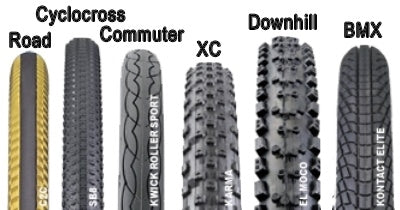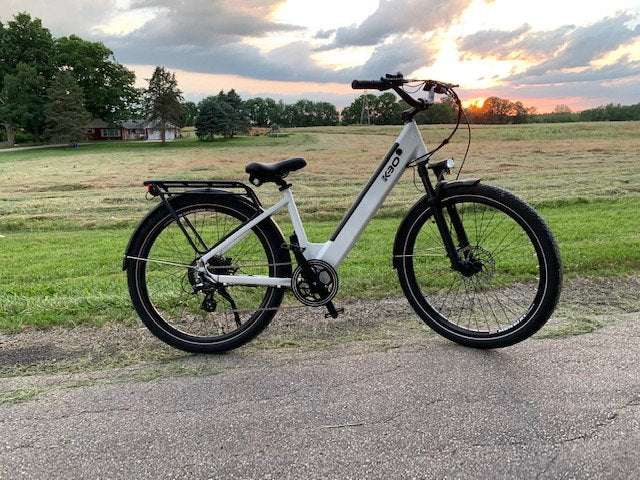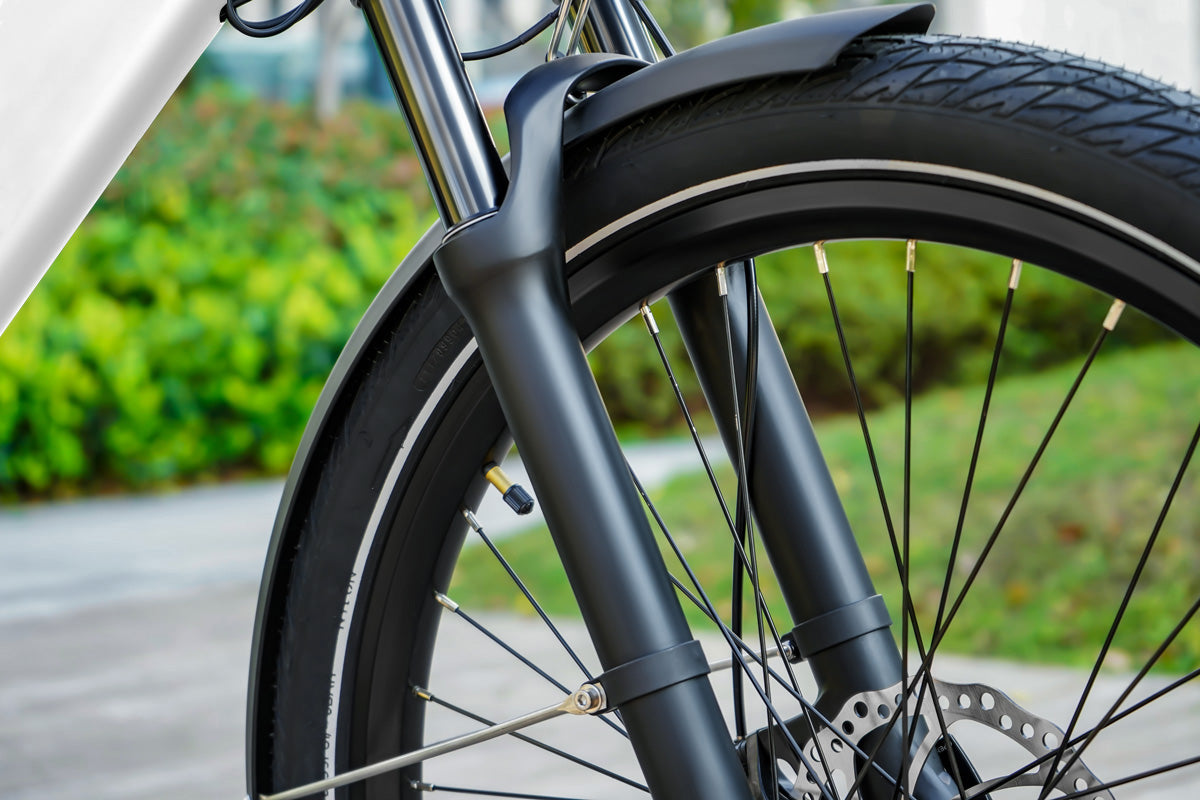How To Choose Electric Bike Tires | KBO Bike
Electric bike wheels are one of the most vital components for your e-bike. The force you exert on the pedals, the brakes you apply, road bumps you ride into, and changes in the direction you make while riding are all associated with the wheels. Wheels affect several aspects of your biking. Therefore the quality of your wheels gives different feels to both your riding experience and safety.
If you intend to use an e-bike and have just a little knowledge about the wheels, read on to seek out the various types and sizes of e-bike wheels and how these differences can impact your choice of wheel.
Different types of Electric bike wheels
We can classify e-bike tires based on two factors: the kind of terrain you are riding on and your riding style.

Road Tire
The width of road tires is usually within 23 to 25 mm with light gross weight. They are skinny. There is a little tread on the tire; the tire has less surface area in contact with the road that reduces friction, and ensures higher riding speed. They can move smoothly on an asphalt surface. The pressure exerted on the ground is minimal, making it much easier to accelerate. This characteristic makes the rider feel lighter. All of these have made road tires the wheel of choice for many people. However, in wet conditions such as in the rain, there is a huge chance of experiencing slips, so road tires might not be advised for someone who lives in an environment with lots of wet weather conditions. The autumn season is coming, here are some electric bike riding tips for you to ride in autumn.
Cyclocross Tire
Cyclocross tires are somewhere between road tires and mountain tires. They have wider widths than road tires, with a width between 30 and 33 mm wide. Additionally, cyclocross tires can be near flat tires, and they have small studs that enable a better grip of the tire in muddy terrains. If you ride in areas with much gravel or mud, Cyclocross tires are well suited for you.
Commuting Bike Tire
People who ride e-bikes for daily commuting mostly ride on common hard surfaces like asphalt or concrete. In these places, the ability to ride safely in wet conditions is of utmost importance. Commuting e-bike tires are designed specifically for this type of riding. The tires are flat, smooth, and have all-weather tread patterns. Their widths are usually between 28mm and 42mm. The wider the tires, the more grip and comfort it provides for the rider due to the increased amount of air volume that can greatly reduce tire pressure. Here are some tips to avoid fat tires.

Mountain Bike Tire
Unlike the thin tires of road e-bikes, mountain bikes have fat tires that are rigid and wide and. These tires have very rough treads that can hold firm to the ground and gain optimum traction even in harsh terrains. They are best suited for riders who ride majorly on surfaces with much dirt, sand, and grass. Additionally, some mountain e-bike tires have natural rubber in their structure. It is believed by some persons that natural rubber has a firmer grip on the trail than synthetics.
BMX Tire
BMX means bicycle motocross. They are bikes made especially for racing on a rough, cross-country course that has constructed obstacles. They have similar tires to mountain e-bike tires because they are somewhat wider and chunky. The majority of BMX bikes' tires are 20 inches wide. Commonly, different styles of BMX riding require different tread patterns and widths. A BMX used for racing makes use of a narrow tire that has a high-level PSI, while BMX used as a freestyle bike requires a wider BMX tire for better grip and a higher than average PSI level for soft landings.
Electric Bicycle Wheel Size
Bicycle wheels are produced in different sizes, ranging from the tiny 12-inch diameter tires to the large 29-inch diameter tires. The performances of e-bikes are determined to a great extent by the size of the wheel size. This is because the wheels determine different aspects of the bikes. Such as the ease of movement, the degree of rolling, and the smoothness of the ride. Below is a brief description of the most common e-bike wheel sizes and their characteristics.
16-Inch E-bike Wheel
A 16-inch wheel is more frequently found in a folding bicycle, which is known to use smaller wheels to reduce weight and, as such, keep the folded size as compact as possible. This ability ultimately allows the bikes to be easily transported. As expected, the quality of the riding is affected by the small size of the wheel. These wheels do not perform well on roads that are rough and bumpy. Because they are quickly affected by even small debris and rocks on the road. In addition, the small turning radius and wheelbase that characterized these kinds of wheels may lead to steering that has increased sensitivity. Having smaller wheels also require that the gear ratio is large enough to get the wheel turning fast enough. For this reason, riding uphill becomes difficult for these wheels.
20-Inch E-bike Wheel
Just like the 16-inch wheels, 20-inch wheels are likely to be found on a folding bike. However, they are more common than the 16-inch wheels. Because of their high quality of being easily maneuvered, they are the standard wheels for BMX tires. Although, riders might still experience some downsides to using these wheels, as they are also easily affected by rocks and obstacles compared to larger standard wheel sizes.
26-Inch E-bike Wheel
These wheels have a long history in the bike industry. They are likely the most common wheel size. They are easily suited for different types of bikes: mountain bikes, road bikes, and even beach cruisers. They have more width and are fatter, and as a result, they have more air volume to disperse as they climb over bumps. This feature makes the riding more comfortable than the earlier mentioned wheels. The 26-inches wheels are better suited for mixed terrains, this means that if you are going on-road and off-road, the 26-inch wheels are yours for the taking. The KBO Step-Thru and the KBO Breeze are equipped with this type of wheel, however a little wider. 27.5 inches high-quality tires that are more resistant to punctures from sharp materials. The tire qualities provide better grip and traction on the roughest terrain.

29-Inch E-bike Wheel
Bikes with this type of wheel were released some years ago. They have a much wider diameter and have less friction, with more ground contact. Having More contact with the ground automatically means better traction. These 29-inch wheels are tagged with the great advantage of having the ability to roll over obstacles while you are riding. Additionally, less energy is required to keep the bike going at a constant speed because they are better at storing their inertia. Furthermore, 29-inch E-bikes have a higher standover height. This means that if you're tall, this is a clear benefit. Though it can be difficult for short riders to fit in.
An additional disadvantage of big wheels is that they weigh more. Also, a longer wheelbase will reduce the maneuverability of the bike, making it slower and giving it a less efficient acceleration compared to bikes if smaller wheels. Bigger wheels transfer less torque to the ground when compared to smaller wheels, even for the same motor.
How to Choose the Right Electric Bicycle Wheel
Below are key factors to consider when you want to choose the right e-bike wheel for yourself:
Should you go for fat tires or thin tires?
E-bikes generally have either fat tires or thin tires, depending on the type. If you will be riding quite often on rough terrains, or paved roads, it is best to go for fat tires. Thin tires, on the other hand, are perfect for smooth roads, not rough roads.
Fat tires
Fat tires function at much lower pressure and have more traction and puncture protection. It allows the bike to operate well on different types of terrains. They are mostly used on mountain bikes and regular road bikes that are ridden on the tarmacs, pavements, gravel floors, beaches, and even snow. While this is so, it is noteworthy that the thickness of the tires has some effects on the speed of the bike, and it can cause extra weight for the bike, ultimately increasing rolling resistance.
Thin tires
Unlike fat tires, thin tires make use of less rubber, and as a result, they are lighter than fat tires. This feature makes them more efficient and easy to handle. They are best suited for smooth roads. Their characteristic higher pressure, lower rolling resistance, and lower traction enables them to easily outpace the thicker tires, both in speed and agility. The disadvantage with them is that they have lower puncture protection and are not as sturdy as the fat tires.
It is super essential to pay attention to the size of the tires. Bigger tires are more likely to be thicker, while smaller and thinner tires come in different sizes. However, if you already own a bike, it bores down to the size of the frame of your bike. If you are new to using e-bikes, it is advised that you spare some time to identify and understand your riding habits and then buy accordingly. If you are more interested in maneuverability and portability, the 16 or 20-inch wheels will be your best fit. However, if you are more in love with riding comfort and speed efficiency, then you should surely consider the big wheels.

















































